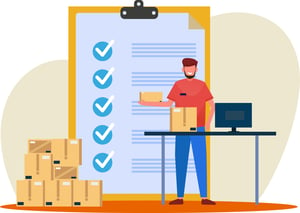Consumer shopping habits and expectations have shifted in recent years. As technology evolves, more people are choosing to buy online instead of visiting retail stores or shopping malls. And the Pandemic only sped up the online shopping trend. Consequently, companies are changing their focus from brick-and-mortar stores to online shopping.
With the rise of ecommerce, customers expect easier online ordering and shorter shipping times. In fact, customer expectations have never been higher. At the same time, costs of goods and labor are increasing, leaving retailers looking for ways to decrease expenses while still meeting customer expectations and demand. As a result, an alternative fulfillment strategy has emerged: microfulfillment. But what is microfulfillment, and what does your business need to do to implement microfulfillment effectively?
Defining Microfulfillment and its Benefits
Traditionally, ecommerce companies have utilized large warehouses or fulfillment centers to fulfill and ship customer orders nationally or regionally. However, in microfulfillment, companies instead fulfill online orders in several smaller regional warehouses geographically close to the customer, usually in strategic urban centers across the country.
With microfulfillment, retailers can ship online orders to customers at faster rates, such as next-day or same-day delivery. Microfulfillment centers (or MFCs) lead to reduced labor and transportation costs as well, with fewer staffing needs and shorter travel times. Having a network of MPCs across the country also gives retailers more flexibility in the event of supply chain disruptions.
Considering Microfulfillment? Implement These Five Best Practices to Get Started
With the ability to reduce logistics costs and maintain customer satisfaction through faster shipping turnarounds, more companies are embracing a microfulfillment strategy. But to make it work for your organization, you must implement these five key best practices to succeed in microfulfillment:
Align Your Inventory Strategy
Pursuing a microfulfillment strategy requires a sizable shift in your inventory management philosophy. After all, a hallmark of microfulfillment is quickly getting the product into your customers' hands. While you will likely still need a centralized distribution center to receive your inventory at the initial stages of your supply chain, having the right amount of inventory spread throughout your microfulfillment centers is critical. To do so, you need a strategy for monitoring your inventory levels at your MPCs and quickly replenishing low stock as needed.
Create a Microfulfillment Network
It’s vital your microfulfillment centers are located in areas that will maximize your cost savings and shipping efficiency. In order to do this, you need to understand where your customers are located throughout the country and establish your MPCs nearby.
To build this microfulfillment network, some companies are turning former retail locations into MPCs. While this can work, you must make sure you can identify sites with access to adequate loading bays near major highways for quick transportation and delivery needs.
Utilize Compatible Software
With microfulfillment, your organization is committed to managing inventory at MPCs around the country and replenishing your stock efficiently. To make this a reality, you must have the right microfulfillment software to keep up.
This software solution needs to integrate with your current e-commerce order management platform and inventory management system. It’s also vital that this software solution provides real-time data to multiple users across the country to keep MPCs stocked correctly and enable your team to quickly respond to rapid inventory changes. This promotes agility within your business, so you can pivot when needed and keep your operations lean.
Build the Right Microfulfillment Team
One sign that a microfulfillment strategy is ideal for your business is high order volumes. But if you’re trying to deliver orders to customers through next-day shipping, you need an efficient team capable of handling high volumes at every MPC. Because of this demand (as well as increased labor costs), some ecommerce companies are considering automated fulfillment technology, such as automated picking and order storage.
If your ecommerce strategy includes at-home delivery, you need to assemble a last mile transportation team at each MPC. This means hiring delivery drivers, renting or managing a fleet of vehicles, using a delivery and shipment provider, or outsourcing this part of your operations to a third-party logistics provider (3PL).
Consider Partnering With a 3PL
Speaking of 3PLs, it’s important to consider outsourcing microfulfillment as part of your overall logistics strategy. Microfulfillment requires a substantial commitment to make it profitable for your business, yet often many companies do not have the time, resources, or knowledge to take it on themselves. As an alternative, 3PLs specialize in supply chain management, so companies have the benefit of entrusting their microfulfillment needs to experienced professionals.
Smart Warehousing: Your 3PL Microfulfillment Experts
At Smart Warehousing, we have the tools and expertise to provide you with customized microfulfillment solutions that help your business scale and grow in a changing consumer landscape. Contact us today to partner with a 3PL that’s provided ecommerce logistics, replenishment, and fulfillment solutions to companies like yours for over 20 years.


